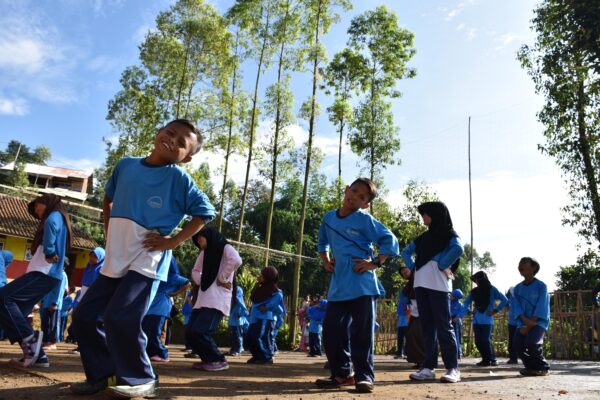Our Little Fireface Project Nature Club (Klub Alam) in Cipaganti has been running since 2013. Twice weekly, local students come to Klub Alam in the school we helped to build, named Mi-Alhidayah, to join us in our nature-based curriculum. We use ground-breaking methods to assess our education programmes. An example can be seen here in our published study in Conservation Biology.

Our programme’s goals are to:
- Inspire a sense of joy and wonder in local children regarding nature and wildlife
- Help children to learn more about their local ecology
- Provide hands-on learning experiences within their own environment ultimately leading to positive behaviour change
Our current project focuses on conservation education regarding civets and other small carnivores. Another key curriculum is Building Bridges for Slow Loris Conservation, where children can learn which slow loris family lives on their land, the ecological role of slow lorises, and how they and their family can have a mutually beneficial relationship with slow lorises. Past curricula have included topics such as:
- Reduce, Reuse, Recycle!
- Agroforestry
- Indonesia’s Unique Plants and Animals
- Whoop Troop: environmental education through storytelling
All of our Klub Alam materials are available for download here
For more information on our education programmes and to learn how you can help, email us at volunteer@littlefireface.org
This abstract describes some of the work that we do:
Conservation professionals recognize the need to evaluate education initiatives with a flexible approach that is culturally appropriate. Cultural-consensus theory (CCT) provides a framework for measuring the extent to which beliefs are communally held and has long been applied by social scientists. In a conservation-education context, we applied CCT and used free lists (i.e., a list of items on a topic stated in order of cultural importance) and domain analysis (analysis of how free lists go together within a cultural group) to evaluate a conservation education program in which we used a children’s picture book to increase knowledge about and empathy for the Javan slow loris (Nycticebus javanicus). We extracted free lists of keywords generated by students (n = 580 in 18 schools) from essays they wrote before and after the education program. In 2 classroom sessions conducted approximately 18 weeks apart, we asked students to write an essay about their knowledge of the target species and then presented a book and several activities about slow loris ecology. Prior to the second session, we asked students to write a second essay. We generated free lists from both essays, quantified salience of terms used, and conducted minimal residuals factor analysis to determine presence of cultural domains surrounding slow lorises in each session. Students increased their use of words accurately associated with slow loris ecology and conservation from 43% in initial essays to 76% in final essays. Domain coherence increased from 22% to 47% across schools. Fifteen factors contributed to the domain slow loris. Between the first and second essays, factors that showed the greatest change were feeding ecology and slow loris as a forest protector, which increased 7-fold, and the humancentric factor, which decreased 5-fold. As demonstrated by knowledge retention and creation of unique stories and conservation opinions, children achieved all six levels of Bloom’s taxonomy of learning domains. Free from the constraints of questionnaires and surveys, CCT methods provide a promising avenue to evaluate conservation education programs.
